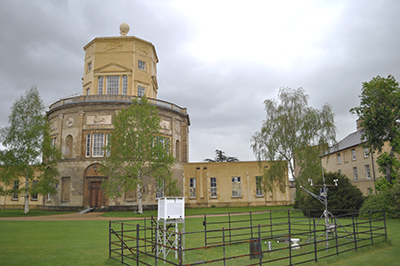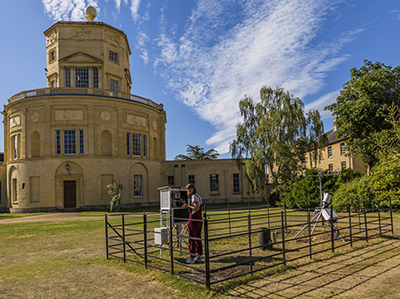Overview and Brief History of the Radcliffe Meteorological Station
 The Radcliffe Meteorological Station is located in the garden of Green Templeton College, adjacent to the Radcliffe Observatory building just off the Woodstock Road, at 51.7612°N, 1.2640°W. The base of the raingauge stands at 63.4 m above mean sea level. Over the years the instruments have occupied various sites around the Observatory, none more than 40 metres from the Observatory building; full details are given in Appendices in Burt & Burt, Oxford Weather and Climate since 1767, OUP 2019. In 1976, the sunshine and wind instruments were removed to the roof of the Engineering Science building, about 230 metres east-south-east of the meteorological enclosure.
The Radcliffe Meteorological Station is located in the garden of Green Templeton College, adjacent to the Radcliffe Observatory building just off the Woodstock Road, at 51.7612°N, 1.2640°W. The base of the raingauge stands at 63.4 m above mean sea level. Over the years the instruments have occupied various sites around the Observatory, none more than 40 metres from the Observatory building; full details are given in Appendices in Burt & Burt, Oxford Weather and Climate since 1767, OUP 2019. In 1976, the sunshine and wind instruments were removed to the roof of the Engineering Science building, about 230 metres east-south-east of the meteorological enclosure.
Meteorological records commenced at the Radcliffe Observatory in 1772; an unbroken daily air temperature record exists from November 1813, daily rainfall from January 1827 and sunshine from February 1880. These are the longest single-site weather records in the United Kingdom, and amongst the longest in the world: they are especially valuable because the instruments in use and their exposure have been fully documented throughout.
In 1768, Dr Thomas Hornsby (1733-1810), then Savilian Professor of Astronomy, approached the Radcliffe Trustees with a request for funds for the erection and equipping of an astronomical observatory. The Trustees responded quickly and generously and building began in 1772. The central feature of the building is the octagonal tower, 33 m high, an adaptation of the Tower of the Winds at Athens. Hornsby was appointed Radcliffe Observer, in effect Director of the Observatory.
Observations of air temperature were taken at observatories to determine astronomical refraction, but other meteorological observations were often made. Hornsby had considerable personal interest in weather records, for he made numerous but irregular observations from 1767 until near his death in 1810: his manuscript records are preserved at the School of Geography and the Environment. Meteorological observations at the Observatory lapsed during Hornsby’s final years, but were resumed in January 1811. After a false start of only a few months, the record recommenced on 14 November 1813 with three daily observations of air temperature, barometric pressure, wind direction, rainfall amounts and weather remarks, and with only very minor interruptions has continued unbroken to this day.

Rainfall observations commenced in 1772, originally on the parapet of the Observatory building around 7m above ground level, relocated to near ground level in August 1850. A previously unknown manuscript record of daily maximum and minimum temperatures from a Six’s thermometer mounted on a north wall from April 1815 was discovered during the preparation of Oxford Weather and Climate since 1767, and has enabled construction of an updated series of monthly mean temperatures for the site.
Publication of the meteorological observations in the annual volumes of the Radcliffe Astronomical Observations commenced in 1849, daily readings being published from 1853 until cessation of the Radcliffe Observations series in 1935. Until August 1849, temperatures were taken from an unscreened thermometer on a north wall, but after this date thermometers were exposed in an early model of thermometer screen. This was itself replaced by a Stevenson screen in December 1878 (a modern aluminium and plastic Stevenson screen remains in use today). From the start, instruments in use were the best available, sourced from the leading instrument makers of the time, while many improvements in observational technique initiated at Kew or Greenwich Observatories in London were soon followed at Oxford – indeed, we believe the reverse to be true in some instances.
Starting in the 1850s, the meteorological instruments were updated, and siting and frequency of observation improved. Autographic and photographic instruments were brought into use to provide continuous records of temperature, wind and rainfall. Since 1881 reliable records exist of all observations made today, except for soil temperatures which have only been recorded since 1925, and temperatures of the concrete surface which have been recorded since 1987. All observations are made to the standards laid down by the Met Office, and the site is regularly inspected by the Met Office.
 Until 1935, when the Radcliffe Astronomical Observatory moved to Pretoria, meteorological observations were a subsidiary task of the Radcliffe Observer and his staff. Since 1935 the meteorological work has been under the direction of the University of Oxford. From 1 July 1935 the station’s official title has been ‘The Radcliffe Meteorological Station, Oxford’. Thanks largely to the generosity and co-operation of the next two occupiers of the site and buildings, from 1934 the Nuffield Institute for Medical Research, and from 1978 the authorities of Green College (now Green Templeton College), and thanks also to a University decree requiring it and (since 1980) support from the Gassiot Fund of the Royal Society, meteorological records have continued unbroken at the Radcliffe.
Until 1935, when the Radcliffe Astronomical Observatory moved to Pretoria, meteorological observations were a subsidiary task of the Radcliffe Observer and his staff. Since 1935 the meteorological work has been under the direction of the University of Oxford. From 1 July 1935 the station’s official title has been ‘The Radcliffe Meteorological Station, Oxford’. Thanks largely to the generosity and co-operation of the next two occupiers of the site and buildings, from 1934 the Nuffield Institute for Medical Research, and from 1978 the authorities of Green College (now Green Templeton College), and thanks also to a University decree requiring it and (since 1980) support from the Gassiot Fund of the Royal Society, meteorological records have continued unbroken at the Radcliffe.
At the Radcliffe Observatory three observations were made each day until the end of 1924. Since 1925 eye-observations have been made once per day, at 0900 GMT, every day of the year, come rain, come shine, including Christmas Day and all other public holidays. Records from sites such as the Radcliffe Meteorological Station are primarily of climatological benefit rather than time-critical observations used in weather forecasting. Only long-established stations can provide a link between the abundant weather records of recent decades and those of the eighteenth and nineteenth centuries, and such sites are few and far between. For this reason, long unbroken single-site meteorological datasets become more valuable with every passing year, and the records of the Radcliffe Meteorological Station remain among the most important in the world.
Data Availability
With the publication of Oxford Weather and Climate since 1767, the full Radcliffe record has been published for the first time. Past and recent observations in both daily and monthly summary format, updated annually, can be downloaded in text or csv format from this website.
Citation
Burt, Stephen and Burt, Tim, 2019. Oxford Weather and Climate since 1767. Oxford University Press, 544pp.




